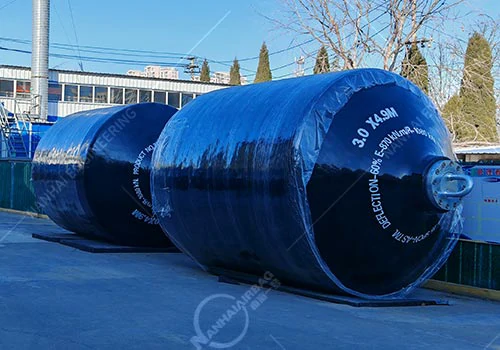Les 5 principales applications des défenses pneumatiques en caoutchouc de Yokohama
07/23/2025Avantages des défenses pneumatiques nervurées
07/24/2025Guide de conception et de personnalisation des défenses remplies de mousse
1. Introduction
Les défenses remplies de mousse sont essentielles pour l'accostage des navires, des plates-formes offshore et des ports.. NANHAI les fabrique pour qu'ils soient légers, durables et qu'ils absorbent l'énergie. Ces défenses en mousse évitent les fuites d'air et restent flottantes en cas de stress.

2. Défenses remplies de mousse Densité : 30-140 kg/m³
2.1 Plages de densité
- 30 kg/m³ (très souple): Idéal pour les petites embarcations. Il réduit la force de réaction mais absorbe moins d'énergie.
- 50-70 kg/m³ (doux à moyen): Équilibré pour la plupart des utilisations.
- 100-140 kg/m³ (dur à extra-dur): Pour les grands navires et les impacts lourds. Il améliore l'absorption d'énergie mais augmente la force de refoulement.
2.2 Absorption d'énergie et force de réaction
La mousse dense absorbe plus d'énergie mais la repousse aussi plus fort. Les concepteurs doivent choisir la densité en fonction du navire et de la résistance du quai nécessaire.
3. Défenses remplies de mousse Effets de taille et de forme
Défenses remplies de mousse sont disponibles dans de nombreuses dimensions. Les diamètres courants vont de 700 mm à 4 500 mm, et les longueurs de 800 mm à 15 000 mm. Les dimensions plus importantes offrent plus de coussin et d'espace à partir du quai, mais coûtent plus cher à fabriquer et à installer.
4. Matériau de l'enveloppe extérieure et renforcement
NANHAÏ utilise un noyau en mousse EVA recouvert d'une coque enduite de polyurée composée de plastique, de nylon et de caoutchouc. Cette enveloppe offre une protection contre l'abrasion, l'huile, l'eau salée, les rayons UV, l'acide et l'alcali.
Certains garde-boue sont recouverts de chaînes ou de filets à pneus pour renforcer la mousse et résister à l'usure.
5. Considérations relatives à la conception personnalisée
Les ingénieurs tiennent compte de l'énergie d'amarrage, des angles, de la hauteur de la marée et de la taille du navire pour choisir la taille, la densité, la forme et les accessoires des défenses. Ils suivent des normes telles que l'AIPCN et les spécifications navales.
6. Essais et contrôle des performances
Les fabricants testent l'absorption d'énergie de la mousse en la comprimant à 60 %. Ils vérifient également la résistance de la peau aux UV, au sel, aux produits chimiques et à la chaleur.
7. Installation et entretien
Les défenses en mousse NANHAI flottent et peuvent être suspendues à des chaînes. Elles ne perdent jamais d'air et ne nécessitent donc pratiquement aucun entretien.
Pour qu'ils fonctionnent bien, vérifiez que la peau n'est pas fissurée, nettoyez-la de la saleté et resserrez les pièces de fixation si nécessaire.
8. Cas d'utilisation
- Petit artisanat: Utilisez de la mousse souple et de petite taille pour éviter d'endommager l'arrimage.
- Ports moyens: Utilisez une densité et une taille moyennes pour une protection équilibrée.
- Grands docks commerciaux/navals: Utiliser de la mousse dure, de grandes dimensions et des filets de renforcement pour un usage intensif. NANHAI personnalise chaque aile en fonction des besoins du client et détient des brevets ainsi que des spécifications militaires.
Pourquoi choisir les défenses en mousse NANHAI ?
- Une expérience éprouvée depuis 20 ans dans les défenses marines et les bouées en mousse.
- Plage de densité 30-140 kg/m³ pour répondre à tous les besoins.
- Grande absorption d'énergie et faible force de réaction assure la sécurité des navires et des quais.
- Mousse EVA durable + peau en polyurée dure de 10 à 15 ans.
- Dimensions, couleurs et formes personnalisées vous permettent de faire correspondre votre quai et vos besoins.
Conclusion
Les ailes en mousse de NANHAI protègent les navires et les quais en absorbant l'énergie et en restant durables. Vous pouvez choisir la densité, la taille, la peau et le design en fonction de vos besoins. Contactez NANHAI pour un devis ou une conception personnalisée adaptée à votre projet maritime.
